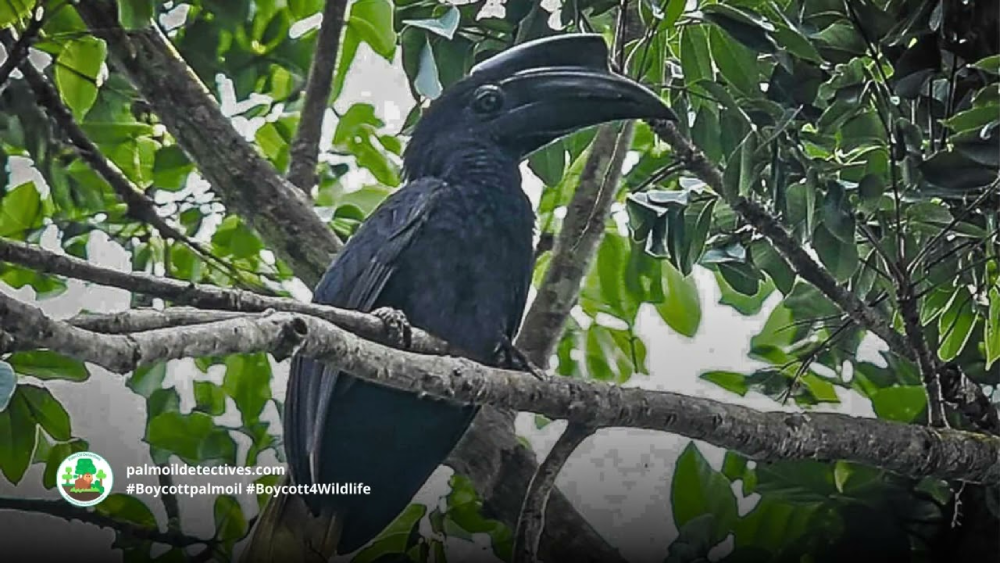The Sulu Hornbill is scientifically popular as Anthracoceros montani. This captivating bird species is endemic to the Sulu Archipelago in the Philippines. Known for its distinctive appearance and unique behaviors, this bird is currently facing severe threats to its survival. This article explores the natural history, ecological significance, and conservation challenges of the Sulu Hornbill. It is highlighting the urgent need for concerted efforts to save this remarkable species from extinction.
Description and Natural History
The Sulu Hornbill is a medium-sized bird, characterized by its striking black and white plumage and a large, curved bill with a prominent casque on top. Males and females exhibit sexual dimorphism, with males typically larger and possessing a more pronounced casque. These birds are highly arboreal, preferring the dense canopy of tropical forests where they feed on a variety of fruits, insects, and small animals.
Their diet primarily consists of fruits, particularly figs, which play a crucial role in seed dispersal within their habitat. This mutualistic relationship between the hornbill and the forest ecosystem highlights the bird’s importance in maintaining the health and diversity of its environment.

Habitat and Distribution
Historically, the Sulu Hornbill lived throughout the forests of the Sulu Archipelago, including the islands of Jolo, Tawi-Tawi, and Bongao. However, rampant deforestation and habitat degradation have drastically reduced their range. Today, the Sulu Hornbill is believed to survive only on Tawi-Tawi. There the remaining forest fragments provide the last refuge for this critically endangered species.
Ecological Significance
The Sulu Hornbill is a keystone species, playing a vital role in the ecological balance of its habitat. As primary seed dispersers, these birds facilitate forest regeneration and biodiversity. By consuming fruits and excreting the seeds at different locations, they help in the propagation of various plant species, which in turn supports a wide array of other wildlife.
Their presence also indicates the health of the forest ecosystem. A thriving hornbill population often signifies a well-preserved environment with adequate food resources and minimal human disturbance. Conversely, their decline is a red flag for broader environmental issues, including deforestation and ecological imbalance.
Threats to Survival
The Sulu Hornbill faces several critical threats, primarily driven by human activities. The most significant of these include:
Habitat Loss and Degradation: The forests of the Sulu Archipelago have been extensively cleared for agriculture, logging, and human settlement. This deforestation has resulted in the loss of suitable nesting and feeding sites, critically endangering the hornbill’s survival.
Hunting and Poaching: The Sulu Hornbill is hunted for its distinctive casque and feathers, which are used in traditional ornaments and sold in the illegal wildlife trade. Despite legal protections, enforcement is weak, and hunting remains a significant threat.
Climate Change: Alterations in climate patterns can affect the availability of food resources and suitable habitats for the hornbills. Increased frequency of extreme weather events, such as typhoons, can further disrupt their already fragile existence.
Limited Range and Small Population Size: Being restricted to a few small islands, the Sulu Hornbill has a very limited geographic range. This isolation, coupled with a small population size, makes them particularly vulnerable to stochastic events and genetic bottlenecks, reducing their ability to adapt to changing environmental conditions.
Conservation Efforts
Efforts to conserve the Sulu Hornbill are ongoing but face significant challenges. Some of the key conservation strategies include:
Habitat Protection and Restoration: Protecting the remaining forest habitats on Tawi-Tawi is critical. This involves establishing protected areas, enforcing anti-logging laws, and promoting reforestation projects to restore degraded habitats.
Community Engagement and Education: Raising awareness among local communities about the importance of the Sulu Hornbill and involving them in conservation efforts is essential. Programs that promote sustainable livelihoods and reduce dependency on forest resources can help mitigate human impact on hornbill habitats.
Research and Monitoring: Conducting comprehensive studies on the population size, distribution, and ecological needs of the Sulu Hornbill is crucial for informed conservation planning. Regular monitoring can help track the effectiveness of conservation measures and identify emerging threats.
Law Enforcement and Policy Advocacy: Strengthening the enforcement of wildlife protection laws and advocating for stronger conservation policies at both local and national levels are vital steps in safeguarding the Sulu Hornbill. This includes cracking down on illegal hunting and trade.
Captive Breeding and Reintroduction: Establishing captive breeding programs can serve as a genetic reservoir and potentially provide individuals for reintroduction into the wild. Such programs must be carefully managed to ensure genetic diversity and avoid inbreeding.
Conclusion
The plight of the Sulu Hornbill is a poignant reminder of the broader challenges facing biodiversity conservation in the Philippines and around the world. As a species teetering on the brink of extinction, the Sulu Hornbill requires urgent and sustained conservation efforts. Protecting this iconic bird is not only about saving a species but also about preserving the intricate web of life that depends on the forests of the Sulu Archipelago.
The survival of the Sulu Hornbill hinges on a multifaceted approach that combines habitat protection, community involvement, rigorous research, and robust policy enforcement. By fostering a deeper understanding of this remarkable bird and its ecological importance, we can galvanize the support needed to ensure that future generations can witness the Sulu Hornbill in the wild, thriving in its natural habitat.









